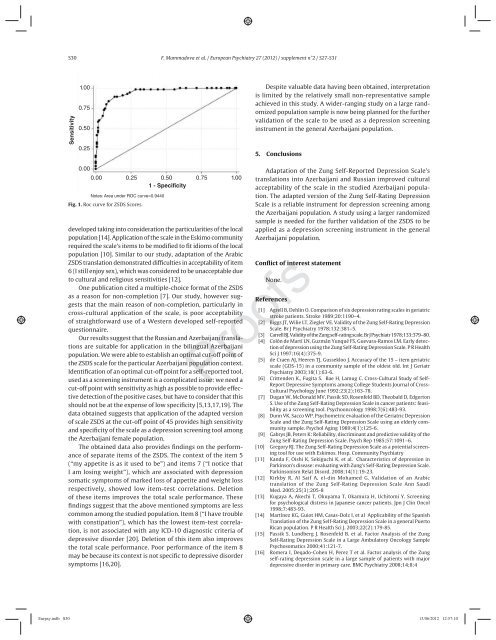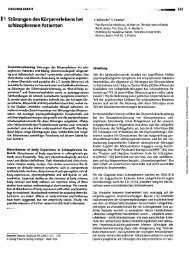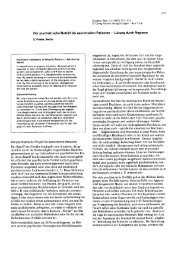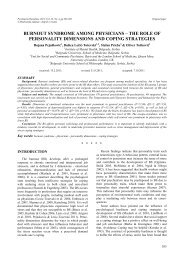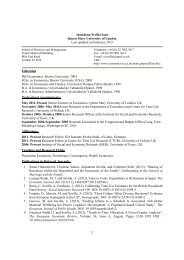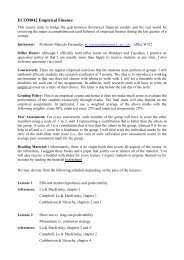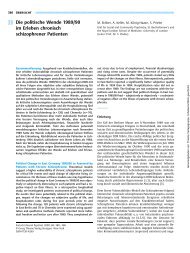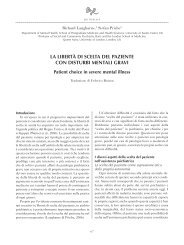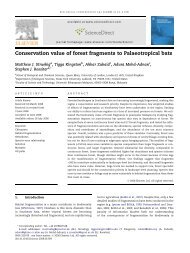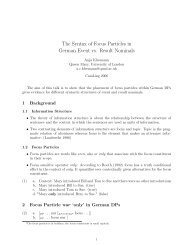Proofs - Personal Webspace for QMUL - Queen Mary, University of ...
Proofs - Personal Webspace for QMUL - Queen Mary, University of ...
Proofs - Personal Webspace for QMUL - Queen Mary, University of ...
Create successful ePaper yourself
Turn your PDF publications into a flip-book with our unique Google optimized e-Paper software.
S30 F. Mammadova et al. / European Psychiatry 27 (2012) / supplement n°2 / S27-S31<br />
Sensitivity<br />
1.00<br />
0.75<br />
0.50<br />
0.25<br />
0.00<br />
0.00<br />
0.25<br />
Notes: Area under ROC curve=0.9440<br />
Fig. 1. Roc curve <strong>for</strong> ZSDS Scores.<br />
0.50<br />
1 - Specificity<br />
0.75<br />
1.00<br />
developed taking into consideration the particularities <strong>of</strong> the local<br />
population [14]. Application <strong>of</strong> the scale in the Eskimo community<br />
required the scale’s items to be modifi ed to fi t idioms <strong>of</strong> the local<br />
population [10]. Similar to our study, adaptation <strong>of</strong> the Arabic<br />
ZSDS translation demonstrated diffi culties in acceptability <strong>of</strong> item<br />
6 (I still enjoy sex), which was considered to be unacceptable due<br />
to cultural and religious sensitivities [12].<br />
One publication cited a multiple- choice <strong>for</strong>mat <strong>of</strong> the ZSDS<br />
as a reason <strong>for</strong> non- completion [7]. Our study, however suggests<br />
that the main reason <strong>of</strong> non- completion, particularly in<br />
cross- cultural application <strong>of</strong> the scale, is poor acceptability<br />
<strong>of</strong> straight<strong>for</strong>ward use <strong>of</strong> a Western developed self- reported<br />
questionnaire.<br />
Our results suggest that the Russian and Azerbaijani translations<br />
are suitable <strong>for</strong> application in the bilingual Azerbaijani<br />
population. We were able to establish an optimal cut- <strong>of</strong>f point <strong>of</strong><br />
the ZSDS scale <strong>for</strong> the particular Azerbaijani population context.<br />
Identifi cation <strong>of</strong> an optimal cut- <strong>of</strong>f point <strong>for</strong> a self- reported tool,<br />
used as a screening instrument is a complicated issue: we need a<br />
cut- <strong>of</strong>f point with sensitivity as high as possible to provide effective<br />
detection <strong>of</strong> the positive cases, but have to consider that this<br />
should not be at the expense <strong>of</strong> low specifi city [5,13,17,19]. The<br />
data obtained suggests that application <strong>of</strong> the adapted version<br />
<strong>of</strong> scale ZSDS at the cut- <strong>of</strong>f point <strong>of</strong> 45 provides high sensitivity<br />
and specifi city <strong>of</strong> the scale as a depression screening tool among<br />
the Azerbaijani female population.<br />
The obtained data also provides fi ndings on the per<strong>for</strong>mance<br />
<strong>of</strong> separate items <strong>of</strong> the ZSDS. The context <strong>of</strong> the item 5<br />
(“my appetite is as it used to be”) and items 7 (“I notice that<br />
I am losing weight”), which are associated with depression<br />
somatic symptoms <strong>of</strong> marked loss <strong>of</strong> appetite and weight loss<br />
respectively, showed low item- test correlations. Deletion<br />
<strong>of</strong> these items improves the total scale per<strong>for</strong>mance. These<br />
fi ndings suggest that the above mentioned symptoms are less<br />
common among the studied population. Item 8 (“I have trouble<br />
with constipation”), which has the lowest item- test correlation,<br />
is not associated with any ICD- 10 diagnostic criteria <strong>of</strong><br />
depressive disorder [20]. Deletion <strong>of</strong> this item also improves<br />
the total scale per<strong>for</strong>mance. Poor per<strong>for</strong>mance <strong>of</strong> the item 8<br />
may be because its context is not specifi c to depressive disorder<br />
symptoms [16,20].<br />
Despite valuable data having been obtained, interpretation<br />
is limited by the relatively small non- representative sample<br />
achieved in this study. A wider- ranging study on a large randomized<br />
population sample is now being planned <strong>for</strong> the further<br />
validation <strong>of</strong> the scale to be used as a depression screening<br />
instrument in the general Azerbaijani population.<br />
5. Conclusions<br />
Adaptation <strong>of</strong> the Zung Self- Reported Depression Scale’s<br />
translations into Azerbaijani and Russian improved cultural<br />
acceptability <strong>of</strong> the scale in the studied Azerbaijani population.<br />
The adapted version <strong>of</strong> the Zung Self- Rating Depression<br />
Scale is a reliable instrument <strong>for</strong> depression screening among<br />
the Azerbaijani population. A study using a larger randomized<br />
sample is needed <strong>for</strong> the further validation <strong>of</strong> the ZSDS to be<br />
applied as a depression screening instrument in the general<br />
Azerbaijani population.<br />
Confl ict <strong>of</strong> interest statement<br />
None.<br />
References<br />
[1] Agrell B, Dehlin O. Comparison <strong>of</strong> six depression rating scales in geriatric<br />
stroke patients. Stroke 1989;20:1190–4.<br />
[2] Biggs JT, Wilie LT, Ziegler VE. Validity <strong>of</strong> the Zung Self- Rating Depression<br />
Scale. Br J Psychiatry 1978;132:381–5.<br />
[3] Carrell BJ. Validity <strong>of</strong> the Zung self- rating scale. Br J Psychiatr 1978;133:379–80.<br />
[4] Colón de Martí LN, Guzmán Yunqué FS, Guevara- Ramos LM. Early detection<br />
<strong>of</strong> depression using the Zung Self- Rating Depression Scale. P R Health<br />
Sci J 1997;16(4):375- 9.<br />
[5] de Craen AJ, Heeren TJ, Gussekloo J. Accuracy <strong>of</strong> the 15 – item geriatric<br />
scale (GDS- 15) in a community sample <strong>of</strong> the oldest old. Int J Geriatr<br />
Psychiatry 2003;18(1):63- 6.<br />
[6] Crittenden K., Fugita S. Bae H, Lamug C. Cross- Cultural Study <strong>of</strong> Self-<br />
Report Depressive Symptoms among College Students Journal <strong>of</strong> Cross-<br />
Cultural Psychology June 1992:23(2):163- 78.<br />
[7] Dugan W, McDonald MV, Passik SD, Rosenfeld BD, Theobald D, Edgerton<br />
S. Use <strong>of</strong> the Zung Self- Rating Depression Scale in cancer patients: feasibility<br />
as a screening tool. Psychooncology 1998;7(6):483- 93.<br />
[8] Dunn VK, Sacco WP. Psychometric evaluation <strong>of</strong> the Geriatric Depression<br />
Scale and the Zung Self- Rating Depression Scale using an elderly community<br />
sample. Psychol Aging 1989;4(1):125- 6.<br />
[9] Gabrys JB, Peters K: Reliability, discriminant and predictive validity <strong>of</strong> the<br />
Zung Self- Rating Depression Scale. Psych Rep 1985;57:1091–6.<br />
[10] Gregory RJ. The Zung Self- Rating Depression Scale as a potential screening<br />
tool <strong>for</strong> use with Eskimos. Hosp. Community Psychiatry<br />
[11] Kanda F, Oishi K, Sekiguchi K, et al. Characteristics <strong>of</strong> depression in<br />
Parkinson’s disease: evaluating with Zung’s Self- Rating Depression Scale.<br />
Parkinsonism Relat Disord. 2008;14(1):19- 23.<br />
[12] Kirkby R, Al Saif A, el- din Mohamed G. Validation <strong>of</strong> an Arabic<br />
translation <strong>of</strong> the Zung Self- Rating Depression Scale Ann Saudi<br />
Med. 2005;25(3):205- 8<br />
[13] Kugaya A, Akechi T, Okuyama T, Okamura H, Uchitomi Y. Screening<br />
<strong>for</strong> psychological distress in Japanese cancer patients. Jpn J Clin Oncol<br />
1998;7:483- 93.<br />
[14] Martínez KG, Guiot HM, Casas- Dolz I, et al Applicability <strong>of</strong> the Spanish<br />
Translation <strong>of</strong> the Zung Self- Rating Depression Scale in a general Puerto<br />
Rican population. P R Health Sci J. 2003;22(2):179- 85.<br />
[15] Passik S. Lundberg J. Rosenfeld B. et al. Factor Analysis <strong>of</strong> the Zung<br />
Self- Rating Depression Scale in a Large Ambulatory Oncology Sample<br />
Psychosomatics 2000;41:121- 7.<br />
[16] Romera I, Deqado- Cohen H, Perez T et al. Factor analysis <strong>of</strong> the Zung<br />
self- rating depression scale in a large sample <strong>of</strong> patients with major<br />
depressive disorder in primary care. BMC Psychiatry 2008;14;8:4<br />
<strong>Pro<strong>of</strong>s</strong>


